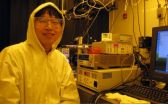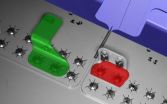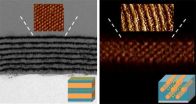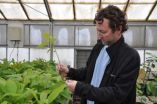(Press-News.org) Taking their cue from the humble leaf, researchers have used microscopic folds on the surface of photovoltaic material to significantly increase the power output of flexible, low-cost solar cells.
The team, led by scientists from Princeton University, reported online April 22 in the journal Nature Photonics that the folds resulted in a 47 percent increase in electricity generation. Yueh-Lin (Lynn) Loo, the principal investigator, said the finely calibrated folds on the surface of the panels channel light waves and increase the photovoltaic material's exposure to light.
"On a flat surface, the light either is absorbed or it bounces back," said Loo, a professor of chemical and biological engineering at Princeton. "By adding these curves, we create a kind of wave guide. And that leads to a greater chance of the light's being absorbed."
The research team's work involves photovoltaic systems made of relatively cheap plastic. Current solar panels are typically made of silicon, which is both more brittle and more expensive than plastics. So far, plastic panels have not been practical for widespread use because their energy production has been too low. But researchers have been working to increase that efficiency with the goal of creating a cheap, tough and flexible source of solar power.
If researchers can increase the plastic panels' efficiency, the material could produce power from an array of surfaces from inserts in window panels to overlays on exterior walls or backpacks.
"It is flexible, bendable, light weight and low cost," Loo said.
In most cases, researchers have focused on increasing the efficiency of the plastic photovoltaic material itself. Recent developments have been promising: a team from UCLA recently announced a system with a 10.6 percent efficiency. That approaches the 10 to 15 percent level seen as the target for commercial development.
Loo said the folding method promises to increase those numbers. Because the technique works with most types of plastic photovoltaic materials, it should provide a boost to efficiency across the board.
"This is a very simple process that you can use with any material," she said. "We have tested it with other polymers and it works as well."
Jong Bok Kim, a postdoctoral researcher in chemical and biological engineering and the paper's lead author, explained in the Nature Photonics paper that the folds on the surface of the panels channel light waves through the material in much the same way that canals guide water through farmland. By curving the light through the material, the researchers essentially trap the light inside the photovoltaic material for a longer time, which leads to greater absorption of light and generation of energy.
"I expected that it would increase the photocurrent because the folded surface is quite similar to the morphology of leaves, a natural system with high light harvesting efficiency," said Kim, a postdoctoral researcher in chemical and biological engineering. "However, when I actually constructed solar cells on top of the folded surface, its effect was better than my expectations."
Although the technique results in an overall increase in efficiency, the results were particularly significant at the red side of the light spectrum, which has the longest wavelengths of visible light. The efficiency of conventional solar panels drops off radically as light's wavelength increases, and almost no light is absorbed as the spectrum approaches the infrared. But the folding technique increased absorption at this end of the spectrum by roughly 600 percent, the researchers found.
"If you look at the solar spectrum, there is a lot of sunlight out there that we are wasting," Loo said. "This is a way to increase efficiency."
The research team created the folded surface in Howard Stone's laboratory in the mechanical and aerospace engineering department by carefully curing a layer of liquid photographic adhesive with ultraviolet light. By controlling how fast different sections of the adhesive cured, the team was able to introduce stresses in the material and generate ripples in the surface. The shallower ripples were classified as wrinkles and the deeper ones are called folds. The team found that a surface containing a combination of wrinkles and folds produced the best results.
Although the math underlying the process is complex, the actual production is straightforward. Loo said it would be quite practical for industrial purposes.
"Everything hinges on the fact that you can reproduce the wrinkles and folds," Loo said. "By controlling the stresses, we can introduce more or fewer wrinkles and folds."
Another benefit of the process is that it increases the durability of the solar panels by relieving mechanical stresses from bending. The researchers found the panels with folded surfaces were able to retain their effectiveness after bending. A standard plastic panel's energy production would be diminished by 70 percent after undergoing bending.
Loo said the researchers drew their inspiration from leaves. Seemingly a simple object, the leaf is a miracle of natural engineering. Its green surface is perfectly constructed to bend and control light to ensure that a maximum amount of solar energy is absorbed to create energy and nutrients for the tree. Recent work by Pilnam Kim, a postdoctoral researcher in Stone's lab, provided insight into how these microscopic structures could be applied to synthetic devices.
"If you look at leaves very closely, they are not smooth, they have these sorts of structures," said Loo, who is deputy director of Princeton's Andlinger Center for Energy and the Environment. "We'd like to mimic this geometric effect in synthetic, man-made light-harvesting systems."
INFORMATION:
In addition to Loo, the researchers included: Howard Stone, the Donald R. Dixon '69 and Elizabeth W. Dixon Professor in Mechanical and Aerospace Engineering at Princeton, Jason Fleischer, an associate professor of electrical engineering at Princeton, Jong Bok Kim, Pilnam Kim, and Nicolas Pégard, a graduate student in Princeton's electrical engineering department; Soog Ju Oh, and Cherie Kagan, of the University of Pennsylvania. Support for the research was provided by the Office of Naval Research, the National Science Foundation, including those through the Princeton Center for Complex Materials, the Air Force Office of Scientific Research, and the Curtin-Stafford Fund at Princeton.
For further information, contact: John Sullivan, Princeton School of Engineering and Applied Science. 609-258-4597. Js29@princeton.edu
Folding light: Wrinkles and twists boost power from solar panels
2012-04-30
ELSE PRESS RELEASES FROM THIS DATE:
NYUCN's Dr. Laura Wagner: Study finds accreditation improves safety culture at nursing homes
2012-04-30
Accredited nursing homes report a stronger resident safety culture than nonaccredited facilities, according to a new study published in the May 2012 issue of The Joint Commission Journal on Quality and Patient Safety.
The study shows that senior managers at more than 4,000 facilities across the U.S. identify Joint Commission accreditation as a positive influence on patient safety issues such as staffing, teamwork, training, nonpunitive responses to mistakes, and communication openness. The findings that accreditation stimulates positive changes in safety-related organizational ...
Slow-growing babies more likely in normal-weight women; Less common in obese pregnancies
2012-04-30
Obesity during pregnancy puts women at higher risk of a multitude of challenges. But, according to a new study presented earlier this month at the American Institute of Ultrasound in Medicine annual convention, fetal growth restriction, or the poor growth of a baby while in the mother's womb, is not one of them. In fact, study authors from the University of Rochester Medical Center found that the incidence of fetal growth restriction was lower in obese women when compared to non-obese women.
Researchers, led by senior study author and high-risk pregnancy expert Loralei ...
Assembly errors quickly identified
2012-04-30
Today's cars are increasingly custom-built. One customer might want electric windows, heated door mirrors and steering-wheel-mounted stereo controls, while another is satisfied with the minimum basic equipment. The situation with aircraft is no different: each airline is looking for different interior finishes – and lighting, ventilation, seating and monitors are different from one company to the next. Yet the customer's freedom is the manufacturer's challenge: because individual parts and mountings have to be installed in different locations along the fuselage, automated ...
Golden potential for gold thin films
2012-04-30
Scientists with the Lawrence Berkeley National Laboratory (Berkeley Lab) and the University of California (UC) Berkeley have directed the first self-assembly of nanoparticles into device-ready materials. Through a relatively easy and inexpensive technique based on blending nanoparticles with block co-polymer supramolecules, the researchers produced multiple-layers of thin films from highly ordered one-, two- and three-dimensional arrays of gold nanoparticles. Thin films such as these have potential applications for a wide range of fields, including computer memory storage, ...
New graphene-based material could revolutionize electronics industry
2012-04-30
The most transparent, lightweight and flexible material ever for conducting electricity has been invented by a team from the University of Exeter. Called GraphExeter, the material could revolutionise the creation of wearable electronic devices, such as clothing containing computers, phones and MP3 players.
GraphExeter could also be used for the creation of 'smart' mirrors or windows, with computerised interactive features. Since this material is also transparent over a wide light spectrum, it could enhance by more than 30% the efficiency of solar panels.
Adapted from ...
lobSTR algorithm rolls DNA fingerprinting into 21st century
2012-04-30
CAMBRIDGE, Mass. (April 27, 2012) – As any crime show buff can tell you, DNA evidence identifies a victim's remains, fingers the guilty, and sets the innocent free. But in reality, the processing of forensic DNA evidence takes much longer than a 60-minute primetime slot.
To create a victim or perpetrator's DNA profile, the U.S. Federal Bureau of Investigation (FBI) scans a DNA sample for at least 13 short tandem repeats (STRs). STRs are collections of repeated two to six nucleotide-long sequences, such as CTGCTGCTG, which are scattered around the genome. Because the ...
New avocado rootstocks are high-performing and disease-tolerant
2012-04-30
RIVERSIDE, Calif. — Avocado, a significant fruit crop grown in many tropical and subtropical parts of the world, is threatened by Phytophthora root rot (PRR), a disease that has already eliminated commercial avocado production in many areas in Latin America and crippled production in Australia and South Africa. Just in California the disease is estimated to cost avocado growers approximately $30-40 million a year in production losses.
Research on developing PRR-tolerant rootstocks to manage the disease has been a major focus of avocado research at the University of California, ...
Big girls don't cry
2012-04-30
A study to be published in the June 2012 issue of Journal of Adolescent Health looking at the relationships between body satisfaction and healthy psychological functioning in overweight adolescents has found that young women who are happy with the size and shape of their bodies report higher levels of self-esteem. They may also be protected against the negative behavioral and psychological factors sometimes associated with being overweight.
A group of 103 overweight adolescents were surveyed between 2004 and 2006, assessing body satisfaction, weight-control behavior, ...
Notre Dame paper examines nanotechnology-related safety and ethics problem
2012-04-30
A recent paper by Kathleen Eggleson, a research scientist in the Center for Nano Science and Technology (NDnano) at the University of Notre Dame, provides an example of a nanotechnology-related safety and ethics problem that is unfolding right now.
The world of nanotechnology, which involves science and engineering down at billionths-of-a-meter scales, might seem remote.
But like most new advances, the application of that technology to everyday experience has implications that can affect people in real ways.
If not anticipated, discussed or planned for, some of those ...
NASA's Landsat satellites see Texas crop circles
2012-04-30
VIDEO:
In this time series animation, vegetation appears red and the bare soil of fallow fields or sparsely vegetated grasslands appear white to green. The blue-gray X near the center of...
Click here for more information.
A water-rich polka dot pattern takes over the traditional rectangular patchwork of fields in this time series animation of 40 years of Landsat images. In the dry Texas panhandle near the town of Dalhart, this transformation is due to center-pivot irrigation, ...




